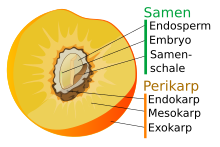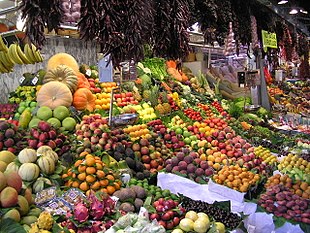fruit
The fruit (from Latin fructus , in technical terms karp- from ancient Greek καρπός ) of a plant is the entirety of the organs that emerge from a flower and that enclose the plant seeds until they are ripe . In principle, fruits only form those plants that have a closed ovary ( bedecktsamer = angiosperms). The naked samers (gymnosperms; this includes conifers and ginkgo trees ) only produce free seeds.
In addition to the carpel, for example, the following organs can be involved in the formation of a fruit : axial tissue (for example the flower base), flower envelope, husks . The fruit is used for expansion . Depending on whether the seeds are enclosed by the fruit or released when ripe , a distinction is made between closing and opening or scattered fruits.
In common parlance, fruit is also understood to mean fruit , and a clear distinction is not always made between seeds and fruit.
Edible parts of plants, which according to different definitions are assigned to vegetables on the one hand and fruit on the other, are referred to as fruit vegetables .
education
Fruits can be formed aerokarp (air fruity): They ripen on the above-ground parts of the shoot. A further distinction is made:
- Chamelokarp: Diaspores on a long axis on the ground
- Euchamelocarp: species with creeping growth
- Pseudochamelocarp: axis flaccid at maturity
Another form is the basic carpie : formation of diaspores (fruits) at the base of a plant, near the ground. Fruits can also be formed geocarpically (earth fruitiness): They ripen underground.
Heterocarpy (different fruitiness): the occurrence of differently shaped fruits. Another possibility is the amphicarpy (double fruitiness ): Term for plants that produce differently shaped fruits on the same individual, with fruits that are formed or ripen at the same time in the air and in the ground.
The pseudocarpie (false earth fruitiness): Here the fruit stalk rolls / contracts and pulls the fruit into the ground.
Trunk fruity ( cauliflora ): Here the fruits develop directly on the trunk or on woody branches. A sub-form is the branch fruitiness ( Ramiflorie ).
construction


A fruit consists of one or more seeds that are surrounded by a pericarp , the pericarp . In the pericarp, on the other hand, there are three layers:
- Exocarp - outer layer
- Mesocarp - middle layer
- Endocarp - inner layer
For example, in the peach in the picture on the right, the endocarp forms the hard core that contains the seed. The mesocarp is fleshy, and the exocarp forms the velvety peach skin.
The pericarp is during the maturation process of the fruit from the ovary of the flower formed. For the classification of fruit, it is important to remind yourself that the ovary of one or more grown together carpels is (carpels).
The remainder of the stem and calyx (sepals) is commonly referred to as cilch .
Classification
Fruits can be classified according to different criteria:
- after sealing the ripe seeds:
- If the pericarp opens after the fruit has ripened and releases seeds, one speaks of an opening or scattering fruit .
- If, on the other hand, the pericarp remains closed and falls off the plant as a whole with the seeds, one speaks of a closing fruit .
- If the seeds at maturity while still enveloped by the pericarp, but breaks down these into several units which may contain one or more seeds, then one speaks of a decay fruit .
- according to water content:
- Dried fruits: The seeds are located in a dry and hard pericarp. They can occur as opening fruits (e.g. pea), closing fruits (e.g. nuts) and cleft fruits (e.g. maple).
- Juicy fruits: In berries the pericarp becomes fleshy and juicy in all its parts, contains sugar and is often colored, in stone fruits only the mesocarp and exocarp.
- according to grouping on the plant:
- The fruits can stand individually (single fruit).
- If the individual fruits of a whole inflorescence form a whole, one speaks of an infructescence (e.g. linden , ears of grain , grapes).
- In the case of flowers with several ovaries, however, it is also possible that a fruit is formed from each ovary, but these fruits then form a whole that normally falls off the plant and is spread together. Such formations are called collective fruits (e.g. strawberries , raspberries , rose hips of roses ).
- If the fruits of an infructescence grow together, so that they can only fall off and spread together, one speaks of a fruit association . Morphologically, the individual fruits involved can be berries, nuts or others (e.g. pineapple , figs ).
These fruit shapes are explained again below.
Single fruits
Fruit of a flower, made up of one or more carpel (fused with one another).
Opening or scattering fruits
The seeds are released when the fruit is ripe. The seeds spread here.
- Follicle : In these, the ovary consists of only one carpel, which grows together at the belly seam and only opens at this one seam when the fruit is ripe.
- Legume : Here, too, the ovary consists of only one carpel, which is fused at the abdominal seam. In contrast to the follicle fruit, the ripe fruit opens not only at this seam (the so-called "belly seam"), but also along the midrib of the carpel, which in this case is also called the "back seam". This fruit shape comes e.g. B. in the legume family .
-
Capsule fruit : In capsules, the ovary consists of two or more fused carpels that open in different ways when the fruit is ripe. Depending on the type of opening, a distinction is made between the following capsule shapes. However, there are also capsules that open irregularly and cannot be assigned to one of these shapes.
- Fissile capsules : The ovaries open on the partitions of the adhesions or along the median nerves of the carpels. In any case, vertical crevices appear on the pericarp. The capsules can open completely, or just pop open at the tip with a few teeth, or only open along the side with cracks.
- Lid capsules : A capsule lid comes off at the upper end.
- Pore capsules : Holes appear on the capsule wall through which the seeds fall out.
- Pod , pod : In these, the ovary consists of two or four carpels that are fused together with so-called placental ridges. When the fruit ripens, two of the carpels separate from the placental ridges, opening the fruit. This fruit shape comes e.g. B. with the cruciferous vegetables or with some poppies . If the pods are less than three times as long as they are wide, one usually speaks of “pods”.
Closing fruits
Seeds remain enclosed by the pericarp until they are spread. The unit of expansion is the fruit.
- Berry : With berries, the pericarp is still fleshy or juicy even when the fruit is ripe (endo- and mesocarp fleshy, exocarp membranous - for example currant , tomato , cucumber and pumpkin ). Many of them dry out just before they are ripe. Berries that dry out regularly and whose fruit wall becomes tough and leathery are called leather berries (e.g. paprika ). Berries usually contain several seeds.
- Nut fruit : Nuts are mostly single-seeded fruits in which the entire pericarp (endo-, exo- and mesocarp) has become woody or leathery (e.g. common hazel ). In many plants with nut fruits, the pericarp is inseparable from the seed. In the case that the ovary was above, one speaks of a caryopsis (e.g. sweet grass ), in the case that it was below it, of an achenes (e.g. composites ).
- Stone fruit : Stone fruits combine characteristics of berries and nuts. With them, the endocarp, i.e. the innermost layer of the pericarp, is woody or leathery. The mesocarp, on the other hand, is fleshy, juicy and soft, the exocarp is membranous (e.g. cherry , plum , elderberry or almond ). Stone fruits are usually solitary.
Decay fruits
-
Fissure fruits : When ripe, the fruit disintegrates along partitions into individual parts, each corresponding to a carpel. The units of spread are partial fruits.
- Doppelachäne : Two partial fruits, which are usually connected by a central fruit holder (carpophor) (e.g. umbellifers )
-
Broken fruit : Here, too, the fruit disintegrates into individual parts along partitions. But these do not each correspond to a carpel, but parts of one or more carpels. The parts are always lonely. One differentiates:
- Articulated pods : Fruits that are formed from a single carpel, but do not spring open along the seam, but rather disintegrate across into single-seeded parts (e.g. Alpine sweet clover ).
- Link pods : fruits made up of two or four carpels that disintegrate transversely when ripe.
- Klausen fruits : With these the fruits disintegrate along the real partitions and also along false partitions. Each carpel thus forms several distribution units when ripe, so that their number is a multiple of the number of carpels. In Central European plants, an ovary consisting of two carpels always breaks up into four parts (e.g. mint family , predatory leaf family ).
Collective crops
They arise from a flower with several or many carpels, each of which forms an independent individual fruit and together represent a unit. Collective fruits are named according to the type of their individual fruits, collective bellows fruits ( kola nut , peony ) with the special shape of apple fruit ( apple or pear ), collective stone fruits ( raspberry , blackberry , cloudberry ) or nut fruits ( strawberry , rose hips ). In the case of collective fruits, the individual fruits are usually referred to in the reduced form. The fruit of the raspberry is, for example, a composite stone fruit, which is formed from several intergrown stone fruits.
Fruit dressings
Fruit associations arise from several or many individual flowers of a whole inflorescence. A single fruit emerges from each of these flowers. However, these are connected by tissue of the inflorescence axis or grow around or grow together in the course of fruit ripening, so that a dummy fruit is created as a unit. Typical examples of fruit dressings are
- the berry fruit association of the pineapple - morphologically a berry has emerged from each individual flower,
- the drupe Association of fig - the jug-shaped inflorescence includes a plurality of tiny flowers from which drupes arise
- the nut fruit bandage of the mulberry
Fruit dressings are particularly widespread in the mulberry family (Moraceae).
Flight fruits
Flight fruits are fruits with special flight facilities, which are adapted to spread by the wind . These include achenes with pappus and wing nuts (samara) as well as special wing fruits (pseudosamara), in which parts of the inflorescence or the base of the flower combine with the fruit to form a flyable diaspore , e.g. B. Valves . The front and cover leaves can also surround the fruit like wings or envelop it like a bag.
See also
- Exotic fruit
- Crop
- Camp fruit
- Fruit vegetables
- Carpology
- False fruit
- Illustration of fruits and vegetables
literature
- Reinhard Lieberei, Christoph Reisdorff: Crop science - founded by Wolfgang Franke . 7th edition. Thieme-Verlag, Stuttgart 2007, ISBN 978-3-13-530407-6 .
Web links
- Fruit pictures from the picture archive of the University of Basel
- Fruits with picture , sorted by season
Individual evidence
- ↑ Marie Lhotská: contribution to the Termiologie Diasporologie. In: Folia Geobotanica et Phytotaxonomica. Volume 10, Issue 1, 1975, pp. 105-108, doi : 10.1007 / BF02855106 .
- ↑ E. Ulbrich: Biology of fruits and seeds ‹Karpobiology›. Springer, 1928, ISBN 978-3-642-51789-1 , pp. 32-38.
- ↑ Fruits and Seeds .


